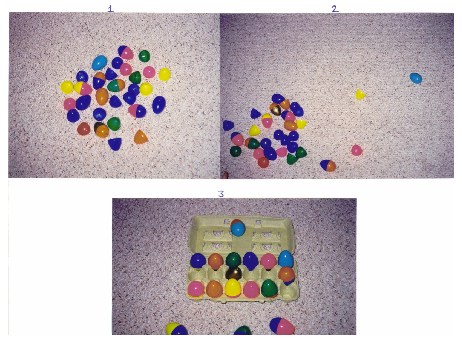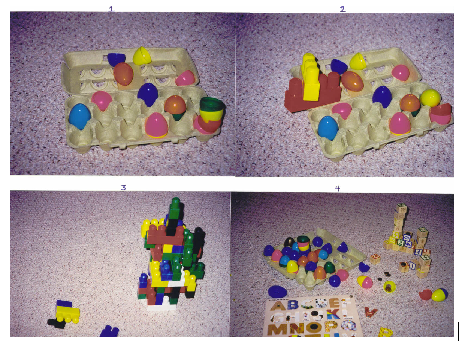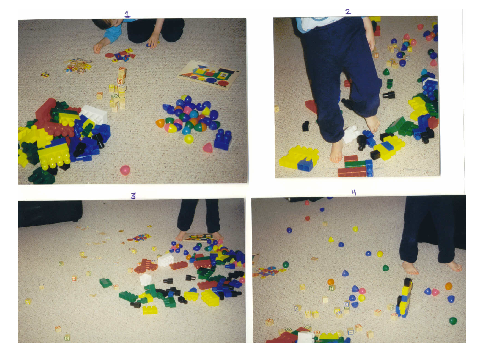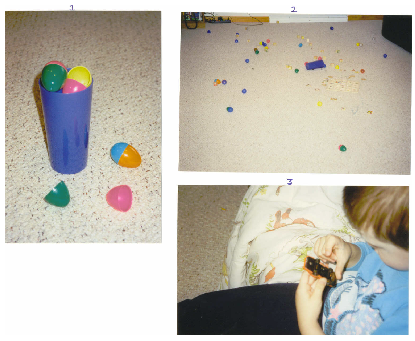Plastic Eggs
Note: Although Zachary never tried to place plastic eggs in his mouth, some children may do so and that could certainly cause a choking hazard...so, again, if you are considering trying any of the exercises I do with Zachary, please make sure to constantly supervise your child as he works with these items.
I discovered that plastic eggs were a fantastic tool in working with Zachary. I used about two dozen in all.
Note: Right mouse click on the image below and select "View Image" to enlarge...make sure you read notes below pictures, too!

Although I did not show it here, the first thing I did with Zachary had to do with color only. I made some eggs a solid color, and others "mixed" ... but all eggs were "whole"... there were no "shell pieces". Zachary did not seem particularly troubled by "mixed color" challenges. I had done the "whole egg" exercise well before writing my first book, Saving Zachary: The Death And Rebirth Of A Family Coping With Autism, and actually figuring out what was wrong with Zachary. When I really started to figure out Zachary's problem, I discovered the "golden eggs" ... because these plastic eggs were fantastic for working with Zachary. I could do so much with them.
The first real exercise I did with Zachary was that shown in picture 1. In picture 1, I put both "whole eggs" with "egg shells" or halves. When I first sat down, all the eggs were in pieces or "shells", broken in two. There was not a single "whole egg" in the bunch. As I started to "put some eggs together", Zachary went absolutely insane.
He wanted all of them to be "shell pieces", not "whole eggs". As I put some together, he worked to pull them apart as fast as he could. When he saw he could not keep up to me, he literally got up and started stomping the eggs with his feet in an effort to pull them apart faster... and as he stomped, he screamed. I kept working with him on this and within just 10 minutes, already he could better tolerate the "whole" vs "partial" egg thing. Having egg parts and egg wholes together, had proved quite stressful for Zachary... and given his issues with partiality, I now understood this completely.
I then went to "phase 2" whereby I placed a few "whole eggs" and "egg shells" slightly away from the "pack". Again, Zachary could not tolerate that. To him, they belonged "all together". Unable to keep me from separating the eggs slightly, a coping mechanism set in... the creation of randomness. He kicked the eggs all over the living room so that they could no longer be perceived as somehow belonging together.
I found that with every exercise, Zachary had to perceive the "group"... meaning that things had to be close enough for him to perceive they "belonged together". When they were all scattered (usually by him), it was as though he did not "perceive" them as part of a group... they were just scattered objects all over the living room, and the distance between them made the fact that they were not "together" more tolerable. Thus, in attempts to cope, I found Zachary either physically separated himself from the objects of frustration, or separated the objects themselves!
Finally, picture 3 shows the addition of an egg carton. Here, I put some eggs in the carton, but others outside of it. Once again, Zachary could not tolerate the lack of "order"... the "partiality" in the situation... he always had to put them back "where they belonged"... all together. If I tried to prevent him from doing that, by removing eggs as he put some in, he literally took the carton and flung it in the air, again, scattering the plastic eggs all over the place.
Another thing I did was provide more eggs than he could fit in the carton. There were a ton of things I found I could do with these simple objects. I also did "combos", as I called them.

In picture 1 above, I put solid colored eggs and two colored eggs in the carton... along with both whole eggs and shells in the carton... in the lower right hand corner of the carton in picture 1, note how I stacked a bunch of shells one inside the other. Then, I added something that just did not belong, a couple of large Lego blocks. Of course, again, that drove Zachary absolutely insane and he quickly removed them.
Picture 3 showed how I could do basically the same type of thing with large Lego blocks. Again, I just stack them in an odd manner and made sure there were a few left over pieces on the floor. I found, at first, Zachary had a very difficult time if the stack "tipped over", but, as I worked with him and kept telling him, "let's make it sturdy", or "it's ok... it's ok", he adjusted much better to the "tipping over". Picture 4 showed how I used a variety of objects at once... again, making sure normal order was broken... introducing many "parts" to the situation and scattering various pieces, slightly away from the rest of the group, etc. In picture 4, I used coins. I later decided to refrain from using any metal objects, including coins... they were just too dangerous...and it was not worth the risk! Many autistic children are known to have eaten metal objects, including metal safety pins, paper clips, thumb tacks, etc. I included this picture in order to make this point on safety, specifically because I knew that if I, personally, had used coins, chances were someone else may, too, and I did not want to see that happen!!!
There are plenty of everyday items that can safely be used in these exercises (i.e., puzzle pieces, egg shells, Lego pieces, pieces of paper, stickers, rubber bands, band aids, spoons, etc.) . The next set of pictures shows Zachary's reaction to the "lack of order"...

Note in picture 1, Zachary was happily "drawing objects" with puzzle pieces - until he noticed the "lack of order" I had created all about him as he had worked quietly. Zachary got up and scattered the objects all about him... The wooden blocks were usually the first to go. I did not know if it was because they were more noticeable from a "3-D" perspective, but, in 99% of the time, they got kicked about first. After that, the plastic egg shells, Lego blocks and puzzle pieces were scattered about in no specific order. For Zachary, there was an intense need to "scatter" everything so that he no longer "perceived" the need to "group" similar objects. There were many times when he literally removed himself physically from the room so as not to see the similar objects I had "unarranged" or "unordered". Finally,

I also used a large cup in working with Zachary (a pot or other container of any kind also worked). The idea here was simply to give Zachary more plastic eggs than he could possibly fit into the container. Again, as he attempted to put all the eggs and egg shells into the cup, in vain, frustration set in and ultimately, the cup and its contents went flying throughout the room, as clearly shown in picture 2. Note that in wanting to deal with the stress, Zachary immediately went for an "order fix"... that was when his coping mechanisms came through... the "spinning" of the wheels on his little orange car, as shown in picture 3, the creation of randomness, the physical removal of himself or of objects, the echolia, the ordering language, etc. Over and over, I have found that if Zachary became too frustrated, he needed his "order fix", either physically, or through the use of his ordering language.
With Zachary, I could explain all his ordering language based on his need for order and the fact that ordering language was a coping mechanism he used to deal with frustration. If he was stressed out, Zachary started uttering things that made sense, or "had order".... things like, "circle, square, triangle....", "fan, fan, fan" (if you think about it, a fan and "spinning" provide "order"... a fan turns in a predictable way... and spinning goes in a predictable way too, eliminating the "parts" or blades because as the fan spins, the blades become part of the whole!).
For Zachary, everything I saw in him in terms of behavior was rooted in his inability to properly integrate his world... in his inability to understand the whole without first understanding the parts that made up that whole!